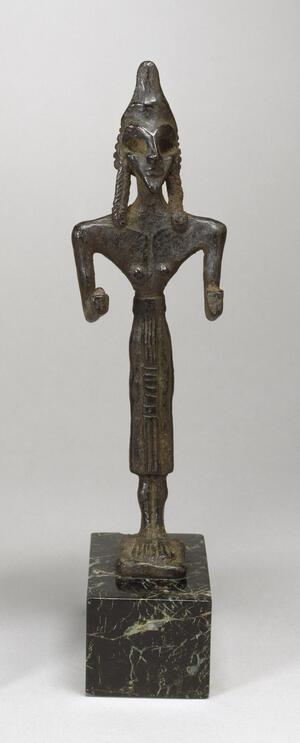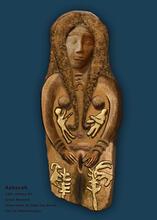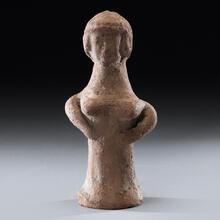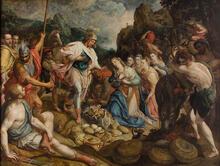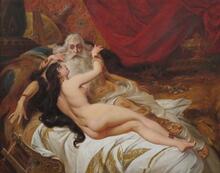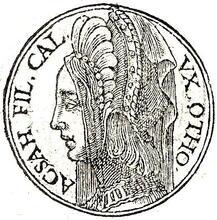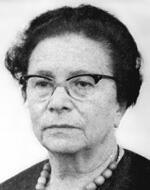Anath: Bible
Anath, sister or consort of the fertility and storm god Baal, early 2nd millenium BCE. From the Walters Art Museum via Wikimedia Commons.
Anath (Anat) is a prominent figure in the Canaanite mythological texts, dating to c. 1400 BCE, discovered at Ugarit on the Syrian coast. She is a maiden/warrior goddess, the sister or consort of the fertility and storm god Baal. She plays a major role in the Ugaritic myths, rescuing Baal from the underworld and defeating Mot, the god of death. Despite her prominence in the Ugaritic texts, she rarely appears in the Hebrew Bible. However, the naming structure used in references to Anath in the Bible indicates that she may have been honored among some Israelites.
Article
Anath (Anat) is a prominent figure in the Canaanite mythological texts, dating to c. 1400 BCE, discovered at Ugarit on the Syrian coast. She is a maiden/warrior goddess, the sister or consort of the fertility and storm god Baal. She plays a major role in the Ugaritic myths, rescuing Baal from the underworld and defeating Mot, the god of death.
In the Hebrew Bible, however, Anath is barely visible. Her name appears only within the place names Beth-anath/anoth (Josh 15:59; 19:38; Judg 1:33) and Anathoth (Josh 21:18; 1 Kgs 2:26; Isa 10:30; Jer 1:1) and the personal names Shamgar ben Anath (son of Anath, in NRSV) (Judg 3:31; 5:6), Anthothijah (1 Chr 8:24), and Anathoth (1 Chr 7:8; Neh 10:19).
These names are generally taken to reflect the worship or veneration of the goddess Anath among Israelites. Beth-anath, for example, means “house or temple of Anath. Anathoth is the plural of the name Anath, just as Ashtaroth (compare Deut 1:4) is the plural of the divine name Ashtar (Astarte). The name Shamgar son of Anath, however, might not mean “Shamgar, son of [the goddess] Anath.” The formula “[personal name], son of [personal name],” usually places one’s father’s name in the second position.
Therefore, the name Anath, in this instance, may be a shortened form of a masculine name such as Anathothijah or Anatyahu, which may simply mean “sign(s) of YHWH.” If so, then Shamgar’s name would have nothing to do with the goddess Anath. Yet because Shamgar was a warrior and Anath a warrior deity, and because place names such as Beth-anoth point to the veneration of the goddess among some Israelites, the label “son of Anath” following Shamgar’s name may indeed connect him with the goddess. Extrabiblical data support such a possibility.
Anath is among a group of three goddesses in the Canaanite texts, the other two being Asherah and Astarte.
Ackerman, Susan. "24. Mirrors, Drums, and Trees." In Congress Volume Helsinki 2010, pp. 537-567. Brill, 2012.
McCarter, P. Kyle, Jr. “Aspects of the Religion of the Israelite Monarchy: Biblical and Epigraphic Data.” In Ancient Israelite Religion: Essays in Honor of Frank Moore Cross, edited by Patrick D. Miller, Jr., Paul D. Hanson, and S. Dean McBride, 137–155. Philadelphia: 1987.
Meyers, Carol, General Editor. Women in Scripture. New York: 2000.
Murphy, Kelly J. "Myth, Reality, and the Goddess Anat: Anat's Violence and Independence in the Ba'al Cycle." Ugarit-Forschungen 41 (2009): 525-542.
Tamber-Rosenau, Caryn. "Striking Women: Performance and Gender in the Hebrew Bible and Early Jewish Literature." PhD diss., 2015. See esp., Chapter 2, “Striking Women in Ancient Mediterranean Literature.”
Tamber-Rosenau, Caryn. Women in Drag: Gender and Performance in the Hebrew Bible and Early Jewish Literature. Gorgias Press, 2018.
Walls, Neal H. The Goddess Anat in Ugaritic Myth. Atlanta: 1992.

